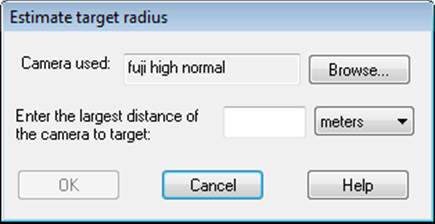


This dialog will calculate the recommended minimum size of a target. Select the camera you will be using for the project by browsing for a .cam or .pmr file. Then enter the approximate distance of the target that is farthest away from the camera. When you press OK the target size will be calculated and entered in the Create Coded Targets Dialog. The calculations done here are to obtain a minimum 15-pixel diameter target which is suitable for most naturally lit targets (that is targets printed out on a black and white laser printer). Retro-reflective targets taken with appropriate flash and exposure settings can often be smaller so use the computed value as a guide. Retro-reflective targets can be 50% to 90% smaller than this computed figure since they have higher contrast and are easier to detect.
If you wish to manually estimate the target size or check the calculations done by this dialog you can use one of two following formulas. For naturally lit targets, we suggest you do not use a target radius smaller than the figures computed here. As described above retro-reflective targets can be smaller than these figures.
The first formula is the coverage formula and is appropriate when most of the targets are a similar distance from the camera. This formula does not require as much knowledge of the camera.
Minimum target radius = 7.5 * w / pw
where 'w' is the width of coverage of each image in real world space, and 'pw' is the number of pixels in the width of the image. For example, if on average each image will cover about 30 feet of the object horizontally and the camera has horizontal pixel resolution of 2048, we get:
Minimum target radius = 7.5 pixels * 360 in / 2048 pixels = 1.31 in (or 33mm).
The second formula is the "distance formula" and is appropriate when you know the approximate distance from the farthest coded target to a camera position. This formula does require more knowledge of the camera parameters and is the one used by the estimate dialog.
Minimum target radius = (7.5 * fw * D) / (f * pw )
where 'fw' is the format width of the camera, 'D' is the distance between the farthest target and a camera position, 'f' is the camera focal length, and 'pw' is the number of pixels in the width of the image. For example, if the farthest target is 8 m away, the camera has a 6.2mm lens, with a 6.0mm format width, and there are 2048 horizontal pixels, we get:
Minimum target radius = (7.5 pixels * 6mm * 8000mm) / (6.2mm * 2048 pixels) = 28.3mm.
With appropriate settings you can fit many targets on one page or just one target per page.